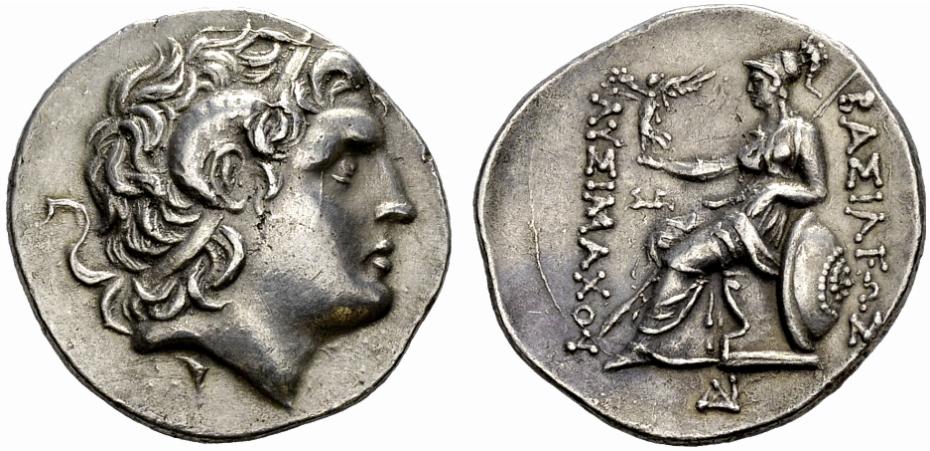Perinthus (Lysimachus), silver, tetradrachms (Alexander/Athena) (280-160 BCE)
From SILVER
280 BCE - 160 BCE Silver 4,519 kg
Description
| ObverseInscription or printing placed on the obverse.: | Diademed head of the deified Alexander with horn of Ammon to r. |
| ReverseInscription or printing placed on the reverse.: | ΒΑΣΙΛΕΩΣ ΛΥΣΙΜΑXΟΥ (Greek).Athena Nikephoros seated to l. Joined foreparts of two horses on l., in exergue monogram ΔΙ. |
Mint and issuing power
| MintIdentifies the place of manufacture or issue of a numismatic object.: | Perinthus | Ancient regionAncient region.: | Thrace | Modern countryModern country: Turkey | AuthorityIdentifies the issuing power. The authority can be "pretended" when the name or the portrait of X is on the coin but he/she was not the issuing power. It can also be "uncertain" when there is no mention of X on the coin but he/she was the issuing power according to the historical sources: | Lysimachus (Macedonian officer, diadochus and king, c. 360-281 BC) |
Chronology
| FromIdentifies the initial date in a range assigned in a numismatic context. | 280 BCE | toIdentifies the final date in a range assigned in a numismatic context.. | 160 BCE | PeriodTime period of the numismatic object.: Hellenistic 323-30 BC |
Physical description
| MetalThe physical material (usually metal) from which an object is made.: | Silver |
Median weightMedian of the weights of numismatic objects (in grams). in grams | 16.90 | DenominationTerm indicating the value of a numismatic object. Examples: tetradrachm, chalkous, denarius.: | tetradrachm |
StandardStandard.: | Attic |
Image

Perinthus_Lysimachus_tetradrachms.jpg [1]
References
| Die study referencePublication of the study: | |||
| Coin series referenceReference to coin series study: | Marinescu 20231Marinescu 2023 | ||
Obverse dies distribution
| FrequencyFrequency of specimen in distribution. ᵖ | Number of obversesNumber of obverse dies. ᵖ (o) | % (o) | Number of coinsNumber of coins. (n) | % (n) | Die nameName(s) of the die(s). |
| 1 | 2 | 16.67 | 2 | 3.39 | 2, 16 |
| 2 | 3 | 25 | 6 | 10.17 | 11, 12, 17 |
| 3 | 2 | 16.67 | 6 | 10.17 | 5, 15 |
| 5 | 1 | 8.33 | 5 | 8.47 | 10 |
| 6 | 1 | 8.33 | 6 | 10.17 | 14 |
| 10 | 1 | 8.33 | 10 | 16.95 | 13 |
| 11 | 1 | 8.33 | 11 | 18.64 | 6 |
| 13 | 1 | 8.33 | 13 | 22.03 | 3 |
| Total | 12 of 12 | 99.99 | 59 of 59 | 99.99 |
Reverse dies distribution
no distribution is available
Quantification
| Number of obversesNumber of obverse dies. ᵖ (o) | 12 | Number of singletons (o1)The number of singleton coins. ᵖ | 2 |
| Number of reverse diesNumber of reverse dies. (r) | 35 | Number of coinsNumber of coins. (n) | 59 |
| Coins per obverse dieNumber of coins per obverse die. (n/o) | 4.92 | Coins per reverse dieNumber of coins per reverse die. (n/r) | 1.69 |
| Reverse per obverse ratioRatio of obverse dies divided by reverse dies. (r/o) | 2.92 | Percentage of singletons (o1)number of coins (n) divided by the number of singletons (o1) ᵖ | 16.67 % |
| Original number of dies (O) (Carter 1983 formula)The estimation of the number of coins according to Carter 1983 ᵖ | 13.37 | Coins struck if 20,000 as average productivity per dieCoins made if the average productivity for obverses (according to Carter) is 20,000. ᵖ | 267,400 |
| Original number of dies (O) (Esty 2011 formula)The estimation of the number of coins according to the singleton formula in Esty 2011 ᵖ (O) | 15.06 | Survival rate if 20,000 as average productivity per dieSurvival rate if average productivity is 20,000. ᵖ | 0.00022 |
| Coverage (o = % of O) (Esty 1984 formula)Esty 1984 - coverage (% of O) ᵖ (o = % of O) | 96.61% | Die productivity if survival rate 1/2,000Average productivity if survival rate is 1/2,000. ᵖ | 8,825.73 |
| Weight of silver (in kg) if 20,000 coins per die (O = Carter formula)Carter 1983 * Median weight * 20000 (*10 if gold or electrum) ᵖ | 4,519 kg <br /> 4,519 kg | Die productivity if survival rate 1/5,000Average productivity if survival rate is 1/5,000. ᵖ | 22,064.32 |
Remarks
Most likely one single workstation Likely military
References
- ^ Marinescu, Constantin A. (2023), "The Lysimachi Coinage of Perinthus," Bulgarian Numismatic Journal, 1 (2), p; 1-28